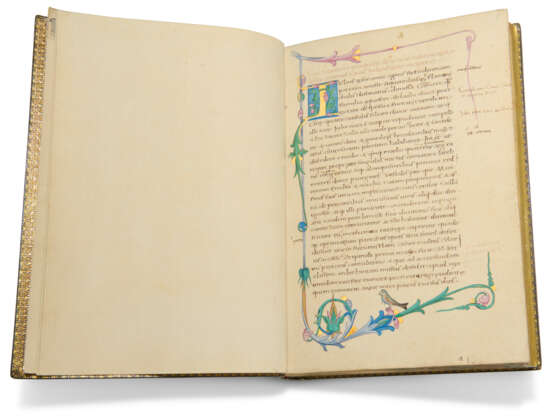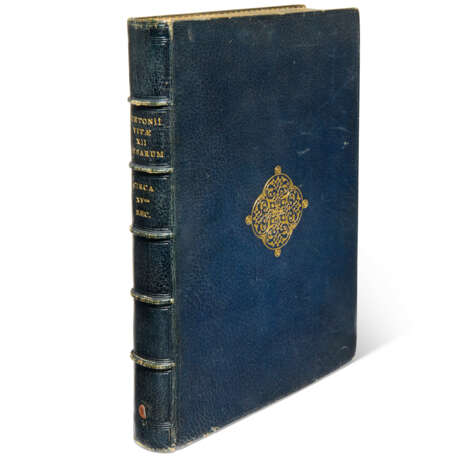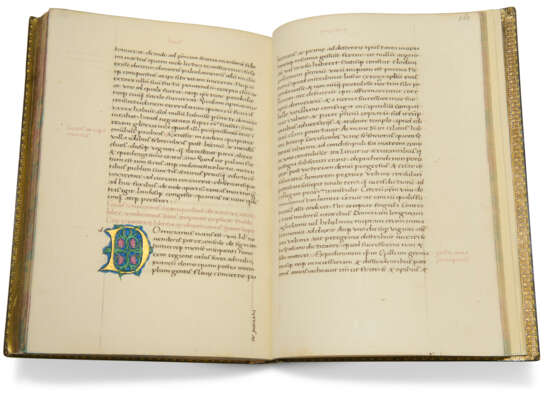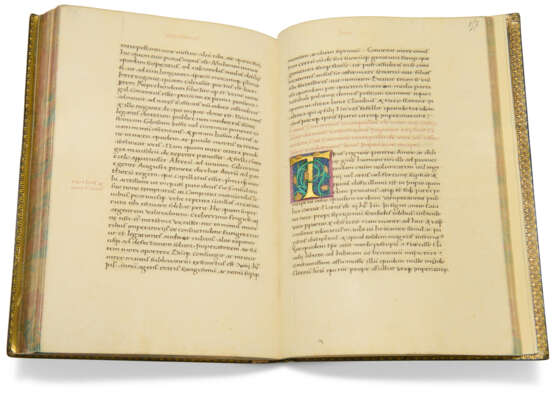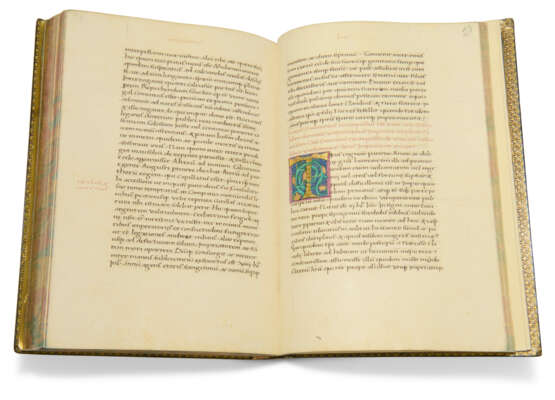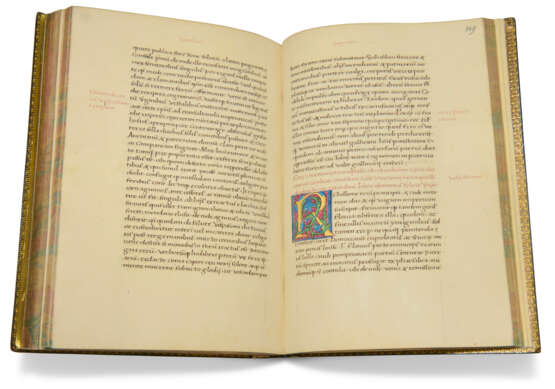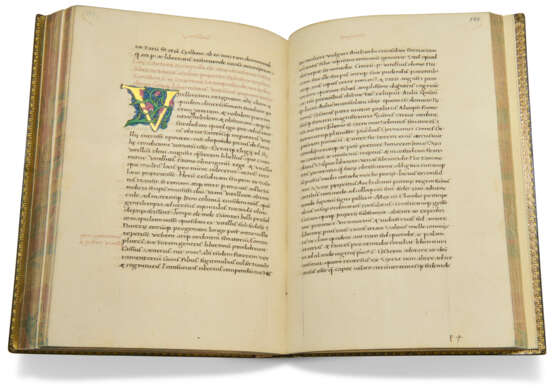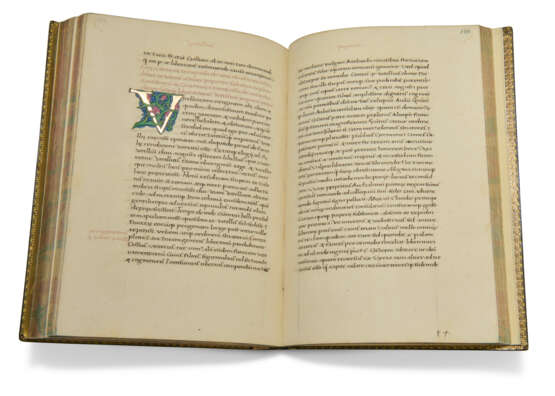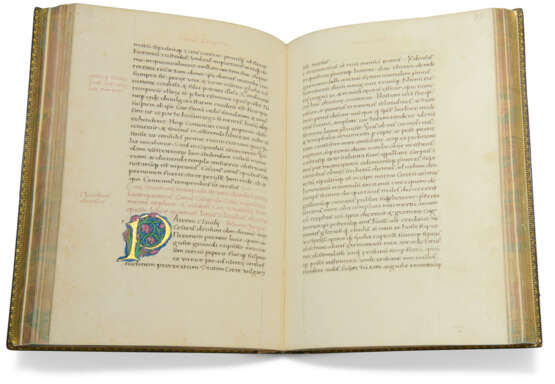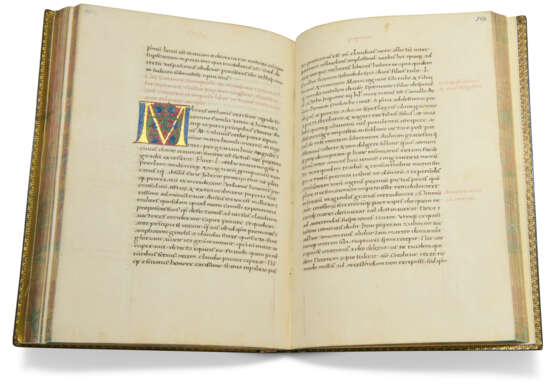ID 1214895
Лот 43 | An Austro-Italian Suetonius
Оценочная стоимость
£ 40 000 – 60 000
Gaius Suetonius Tranquillus (c.69-c.122), Vitae XII Caesarum, in Latin, illuminated manuscript on paper [probably written in Italy and illuminated in Austria (Salzburg), c.1460s]
An interesting text illuminated by Ulrich Schreier, in wonderfully fresh condition, in a pretty binding.
240 × 170mm. 169 leaves, with a watermark of a letter ‘n’ in a circle, close to Piccard nos. 28984–88 (Ravenna 1458, Bologna 1463), complete, collation: 1–1610, 179 (of 10, last blank cancelled), vertical catchwords and alpha-numeric leaf signatures throughout, ruled for both the tops and bottoms of minims (a sign of a very high-grade production) for 30 lines per page, ruled space: c. 160 × 105mm, written in Humanistic minuscule, headings and side notes in pale red, illuminated with twelve large initials, the first with a three-sided border of foliage incorporating a bird (a few margins with stains, but generally in fine condition), sewn on 5 bands and bound (by 1876) in very pretty gilt blue morocco signed by Lortic and with his label, the spine with title in gilt capitals ‘Suetonii Vitæ XII Cæsarum / Circa XVum sæc.’, gilt edges and turn-ins, marbled endleaves, green silk place-markers (slightly scuffed, the corners bumped).
Provenance:
(1) The watermarks and script suggest that the text was written in Italy, but the illumination is by Ulrich Schreier of Salzburg (active between 1457 and 1490) or his workshop; see Illumination); it was therefore perhaps made for Johannes Tröster (c.1425-1485), German humanist and canon of Regensburg Cathedral, for whom Schreier illuminated at least three other books.
(2) Ambroise Firmin-Didot (1790–1876), printer, publisher, scholar, and bibliophile, of Paris: with his 1850 oval bookplate; in his sale by Delestre & Labitte, Paris, 6 June 1878, lot 59 (‘Grandes marges. Conservation parfaite.’)
(3) Gustav von Emich (1843–1911), Hungarian minister to Berlin and collector, of Budapest: sold as ‘The Property of a Gentleman in Austro-Hungary’ at Sotheby’s, 20 June 1900, lot 111; bought for £9 by Dickson.
(4) Joseph Baer & Co., Frankfurt, Katalog 500 [1908?], no 12, priced M.300.
(5) Karl W. Hiersemann, Leipzig, Katalog Nr. 460: Handschriften, Inkunabeln und wertvolle Ausgaben der Klassiker des Altertums der Humanisten und Neulateiner enthaltend den betr. Teil der Bibliothek des Kunstmalers F. von Schennis und andere Sammlungen, 1918, no 174.
(6) Paul Graupe, Berlin, Katalog Nr. 57: Manuskripte, Inkunabeln […], 14 December 1925, lot 20.
(7) Unidentified collector’s mark ‘E K’ within an oval (f.iir; not in Lugt).
(8) Maggs Bros., London: sold on 12 November 1959 to:
(9) Major John Roland Abbey (1894–1969), soldier, brewery owner, and bibliophile: with his gilt leather book label and acquisition notes, his ‘JA 6963’; his sale at Sotheby’s, 1 December 1970, lot 2885 (with full-page plate), bought for £400 by Roman.
(10) Sotheby’s, 21 June 1988, lot 89 (with full-page plate); bought by Ferrini.
(11) The Schøyen Collection, MS 118.
Content:
‘Caij Suetonij tranquilli de vita duodecim Cęsarum liber primus, Caius Julius Caesar incipit. Iulius Caęsar annum agens sextumdecimum patrem […] in sequentium principium, deo gratias’, ff.1–169v. Passages left blank for the insertion of Greek.
Suetonius’s Lives of the Twelve Caesars covers the Roman Emperors from Julius Caesar (d. 44 BC) to Domitian (d. 96 AD). He began the biographies when he was secretary at the imperial palace under Trajan, and completed them c. 120 AD. He is the main source of the famous story of Julius Caesar crossing the Rubicon, and his assassination in the Senate, Nero singing while Rome burned, and many others. He was a friend of Pliny the Younger, who described him as ‘quiet and studious, a man dedicated to writing’. He was secretary to the Emperor Hadrian, who dismissed him for allegedly having an affair with the Empress.
Fewer than twenty manuscripts of the text pre-date the 14th century, most of them being only excerpts. Only ten belong to the following century, and two of these were owned by Petrarch, who included it on his list of favourite books; he also managed to obtain one of the few 12th-century copies. Boccaccio likewise showed a keen appreciation of the text. Most surviving manuscripts date from after 1400, and from 1470 they were joined by two editions printed in Rome and a third printed in Venice the following year.
Illumination:
The style of illumination is very unusual and in remarkably fresh, bright, condition. The initial letters themselves are in highly burnished gold with punched decoration, enclosing and being enveloped by foliage in an unusual palette of blue-grey, dark blue, purple-blue, pink-purple, burgundy red, pale green, olive-green, all with highlights, accents, and ornament in white. These are extremely similar to Munich, Universitätsbibliothek, 2 Cod. ms. 549, illuminated by Ulrich Schreier for the Humanist Johannes Tröster (see M. Schuller-Juckes, ‘Johannes Tröster als früher Auftraggeber des Salzburger Buchkünstlers Ulrich Schreier’, Pirckheimer Jahrbuch für Renaissance und Humanismusforschung, 23 (2008), pp.233–45, and more generally her Dr.Phil dissertation: Ulrich Schreier und seine Werkstatt: Buchmalerei und Einbandkunst in Salzburg, Wien und Bratislava im späten Mittelalter, Vienna University, 2009), especially abb. 34–39). The Munich manuscript has Tröster’s inscription explicitly stating that he acquired it without binding or illumination, and that Schreier was paid for the latter (the inscription is reproduced by Schuller-Juckes, 2008, Abb. 1, and in her thesis, Abb. 33).
Schreier trained as an illuminator in Salzburg and is known to have worked from 1457 to 1490, spending the later part of his career in Vienna und Bratislava. His books for Tröster can be dated to the 1460s, and the strange style is a native Austrian illuminator’s attempt to paint in a style based on, or at least inspired by, Italian Humanistic manuscripts. We are grateful to Michaela Schuller-Juckes for confirming that the illumination is by Ulrich Schreier.
The twelve initials are on ff.1, 23v, 55v, 77v, 96v, 113, 132v, 139v, 143v, 149, 157, and 160v.
| Место происхождения: | Австрия, Западная Европа, Европа |
|---|---|
| Категория аукционного дома: | Манускрипты Средневековья и Ренессанса, Книги и рукописи |
| Место происхождения: | Австрия, Западная Европа, Европа |
|---|---|
| Категория аукционного дома: | Манускрипты Средневековья и Ренессанса, Книги и рукописи |
| Адрес торгов |
CHRISTIE'S 8 King Street, St. James's SW1Y 6QT London Великобритания | |
|---|---|---|
| Предосмотр |
| |
| Телефон | +44 (0)20 7839 9060 | |
| Комиссия | see on Website | |
| Условия использования | Условия использования |
